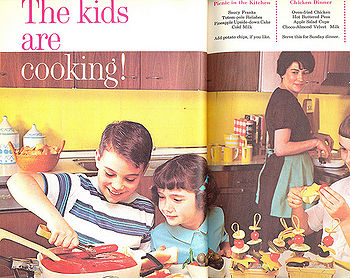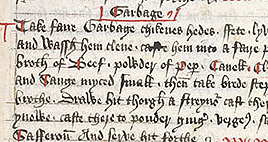Course:LIBR548F/2009WT1/Cookery Books

Definition
'Cookery book', or 'cookbook', is defined as "a book of cooking directions and recipes," or, more broadly, "a book of detailed instructions."[1]
Early cookery books
The first cookery book, Hedypatheia, was written in 350 BC by Archestratus.[2] In the 2nd Century BC, a Greek gourmet named Athenaeus wrote Deipnosophistai as a conversation between two banqueters who talk about recipes.[3] 1st Century Roman merchant Apicius's cookery book was so revered that it was preserved and re-issued for twenty centuries.[4] Early cookery books included health and diet information as well as cookery tips and recipes.[5]

Medieval cookery books
The oldest known cookery book written in English is The Forme of Cury ("cury" meaning "cookery"), which is said to have been written by the master chef of Richard II's court (1377 - 1399).[7] The Forme of Cury instructed chefs how to cook for everyday meals as well as special banquets. Other cookery books from that era, such as Boke of Kokery, included the names and ingredients of recipes the reader would already be familiar with, but not instructions on how to make the meals; rather, it included tips for chopping meat, flavoring meals, and preventing food theft.[8]
Renaissance cookery books
With the advent of the printing press, cookery books became more widely available.[9] The first known to be printed was an Italian sweets cookbook by Bartolema Scappi, in 1485.[10] Cookery books began to be published regularly in the 1500s, many of which were aimed at the affluent 5 to 10 percent of women who were literate at the time.[11] These books included instructions on cooking, animal husbandry, carving, sewing, and various other duties of servants.[12]
Restoration Age cookery books
After Charles I was deposed and beheaded, many chefs found themselves unemployed. It is suspected that these chefs' desperation for a source of income is one of the reasons for the increase in cookery book publications.[13] The first English cookery book written by a female was The Queen-like Closet by Hannah Wolley, in 1670.[14] Wolley's book was among the first to address readers of a lower class, containing simplified and inexpensive recipes for those with a modest income.[15]
Industrial Revolution cookery books
With the implosion of the middle class in England, many cookery books started to be written in simplified English for the readership of the many servants of middle class mistresses.[16] The Art of Cookery Made Plain and Easy (1747) made its author, Hannah Glasse, a housewife, the most popular cookery book author of the age, even though over one third of her recipes were lifted from other books (a common money-making scheme of the time).[17][18]
Victorian cookery books
The most famous Victorian cookery book was Isabella Beeton's Beeton's Book of Household Management (1859-1861).[19] Of its 1112 pages, recipes took up only three quarters; the last quarter focused on other household instructions to be carried out by household staff and servants.[20][21] Alexis Soyer was one of the first celebrity chefs, and his Shilling Cookery for the People (1855) was aimed at improving the culinary lives of the poor.[22]
The development of genres
Cookery books were an all encompassing genre of their own until 1843, when Piscator published Britain's (and possibly the world's) first cookery book devoted to fish, after which cookery books devoted to specific ingredients proliferated.[23] British cookery books dealt mainly in British and French foods until the early 19th century, when they began to integrate recipes from other countries due to the increasing popularity of travel among those who were likely to write cookery books, and the public's fascination with the exotic.[24] In the mid-19th century, books devoted to ethnic cookery, such as The Jewish Manual, started to appear.[25] New genres of cookery books developed in the Victorian Age, establishing all of the main genres by the beginning of the 20th Century.[26]
Modern cookery books
New minor genres of cookery books evolved in the 20th Century along with social trends: for example, low-calorie cookbooks emerged as calories became a popular health concern,[27] and Hard-Time Cookery during wartime rationing.[28] The first book written and published in the independent United States of America was similarly a new brand of cookery book: American Cookery, or the Art of Dressing Viands, Fish, Poultry and Vegetables, and the Best Modes of Making Pastes, Puffs, Pies, Tarts, Puddings, Custards and Preserves, and All Kinds of Cakes, from the Imperial Plumb to Plain Cake. Adapted to This Country and All Grades of Life by Amelia Simmons, an American Orphan was written for women who did their own cooking and cleaning, a type of cookery book that became commonplace as the women's solidarity movement progressed.[29] The further democratization of cooking came with Fannie Merritt Farmer's standardization of methods and measurements in 1896.[30]
The effect of television
When cooking instructions started appearing on television cooking shows, cooking started to be perceived as a leisurely activity,[31] and television personalities and networks started producing their own cookbooks.[32] Cookbook sales have soared since the advent of televised cooking shows,[33] and have become a mainstay of the publishing world in the last hundred years.[34]

The effect of the Internet
The wide availability of free blogs has brought many culinary authors to a new medium for the transmission of recipes. Food blogs are so prevalent that they have had their own category at the Bloggies (the international blogging awards) since 2005.[35] Regular people, along with celebrity chefs, have turned to the Internet to broadcast their recipes to a community of everyday chefs.[36] Cooking blogs commonly include not only recipes but critiques of printed cookbooks.[37] They also include reader comments, shifting the cookery book into an interactive genre wherein reader comments provide additional information to other readers immediately alongside the blog author's text.[38]
Footnotes
- ↑ cookbook 2009, in Merriam-Webster Online Dictionary.
- ↑ cookbook 2009, in Encyclopaedia Britannica.
- ↑ cookbook 2009, in Encyclopaedia Britannica.
- ↑ cookbook 2009, in Encyclopaedia Britannica.
- ↑ Davidson 2001, p. 99.
- ↑ Books for Cooks 2009, Medieval foods: Boke of Kokery.
- ↑ Books for Cooks 2009, Medieval food: The Forme of Cury.
- ↑ Books for Cooks 2009, Medieval food: Boke of Kokery.
- ↑ cookbook 2009, in Encyclopaedia Britannica.
- ↑ cookbook 2009, in Encyclopaedia Britannica.
- ↑ Books for Cooks 2009, 1500s food.
- ↑ Books for Cooks 2009, 1500s food.
- ↑ Books for Cooks: 1600s food.
- ↑ Books for Cooks 2009, 1600s food: The Queen-like Closet.
- ↑ Books for Cooks 2009, 1600s food: The Queen-like Closet.
- ↑ Books for Cooks 2009, 1700s food.
- ↑ Books for Cooks 2009, 1700s food: The Art of Cookery.
- ↑ Davidson 2001, p. 102.
- ↑ Gorlach 1992, p. 751.
- ↑ Gorlach 1992, p. 751.
- ↑ Books for Cooks 2009, 1800s food: Beeton's Book of Household Management.
- ↑ Books for Cooks 2009, 1800s food: Soyer's Shilling Cookery.
- ↑ Davidson 2001, p. 104.
- ↑ Davidson 2001, 104.
- ↑ Davidson 2001, p. 105.
- ↑ Davidson 2001, p. 105.
- ↑ Wolf & Byrd 1991.
- ↑ Books for Cooks 2009, 1900s food: Hard-Time Cookery.
- ↑ Wolf & Byrd 1991.
- ↑ cookbook 2009, in Encyclopaedia Britannica.
- ↑ Wolf & Byrd 1991.
- ↑ cookbook 2009, in Encyclopaedia Britannica.
- ↑ Wolf & Byrd 1991.
- ↑ cookbook 2009, in Encyclopaedia Britannica.
- ↑ de Solier 2007, p. 2.
- ↑ de Solier 2007, p. 2.
- ↑ de Solier 2007, p. 3.
- ↑ de Solier 2007, p. 6.
References
- Books for Cooks (2009). Retrieved September 23, 2009, from British Library Online: http://www.bl.uk/learning/langlit/booksforcooks/booksforcooks.html
- cookbook (2009). In Encyclopædia Britannica. Retrieved September 20, 2009, from Encyclopædia Britannica Online: http://www.britannica.com/EBchecked/topic/136079/cookbook
- cookbook (2009). In Mirriam-Webster Online Dictionary. Retrieved September 20, 2009, from http://www.merriam-webster.com/dictionary/cookbook
- Davidson, Alan (2001). The natural history of British cookery books. American Scholar 52(1). 98-106.
- de Solier, Isabelle (2007). Foodie blogs: Cookbooks, recipes and gustatory identities. Cookery Books as History: Australian and New Zealand Approaches. Retrieved September 20, 2009, from http://www.hss.adelaide.edu.au/centrefooddrink/papers/de.solier.pdf
- Gorlach, Manfred (1992). Text-types and language history: The cookery recipe." In History of Englishes: New Methods and Interpretations in Historical Linguistics. Ed. Matti Rissanen, Ossi Ihalainen, Terttu Nevalainen, Irma Taavitsainen. New York: Mouton de Gruyter.
- Wolf, Thomas J., Byrd, R.J. (1991). Once upon a time a cookbook was a recipe for excess. Smithsonian 22(8). 118-126.
Recommended Reading
Books for Cooks (2009). British Library Online. [1]
- This website describes a handful of British cookery books from each century. Each section introduces the historical backdrop of the era, and provides an overview of a few cookery books from that age, complete with photos. An essential read for anyone desiring a holistic view of British cookery book history.
Davidson, Alan (2001). The natural history of British cookery books. American Scholar 52(1). 98-106.
- A useful source of information for less popular cookery books of Britain's history. This article explains the emergence of different genres and the social changes that contributed to the cookery book's evolution.
de Solier, Isabelle (2007). Foodie blogs: Cookbooks, recipes and gustatory identities. Cookery Books as History: Australian and New Zealand Approaches. [2]
- This article was prepared for a conference on Australian and New Zealand history through the analysis of cookery book evolution, and is one of the only scholarly papers focused specifically on cooking blogs.